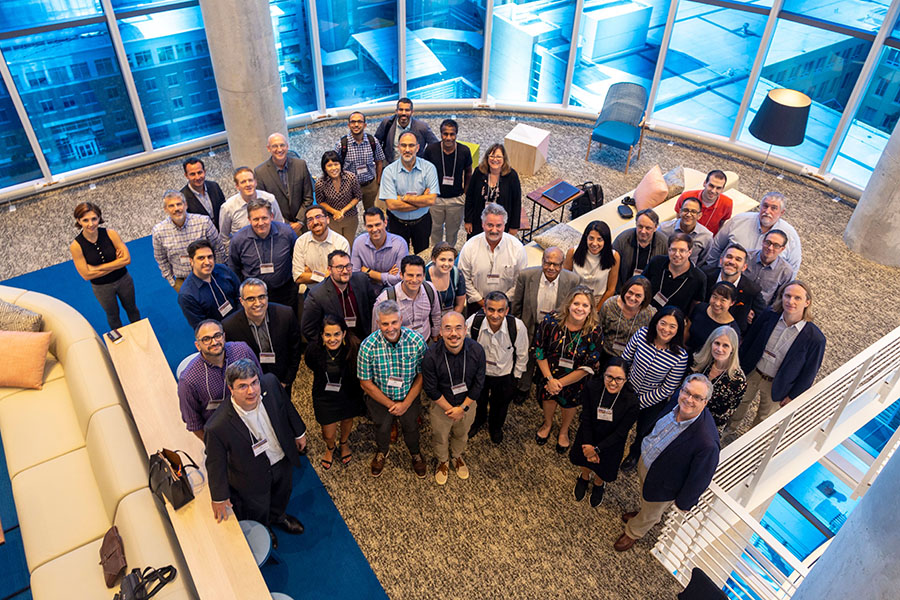
|
 National leaders in smart city digital twin technology gathered at the Coda Building at Georgia Tech Sept. 16-17. (Photo By: Amelia Neumeister) |
As communities look to improve service through technology, more and more are interested in an emerging field known as smart city digital twins—a concept that originated here at Georgia Tech.
A Smart City Digital Twin is a virtual platform that utilizes data and internet-of-things technology to replicate and emulate changes happening in a real city’s infrastructure systems to provide insight that could help improve sustainability, resilience and livability.
John Taylor, the Frederick Law Olmsted Professor in the School of Civil and Environmental Engineering, published the first research paper on smart city digital twins in 2017 along with Neda Mohammadi, the city infrastructure analytics director of the Network Dynamics Lab at Georgia Tech. In just two years, interest and research on the topic has grown rapidly.
ABI Research predicts that there will be more than 500 smart city digital twins in operation by 2025
So what will that near future look like?
Leaders in the field gathered at Georgia Tech recently to discuss the possibilities. Funded by the National Science Foundation, the Smart City Digital Twin Convergence Workshop was held Sept. 16-17 at the Coda building in partnership with Stanford University, Columbia University and the University of Illinois at Chicago.
The workshop brought together a hand-selected group of thought-leaders in the realm of smart city digital twins, representing eight municipal governments, three national laboratories, six industries and 17 universities with representatives from 15 disciplines.
The wide array of attendees underscores the interdisciplinary nature of the research, which has applications for engineers, data scientists, city planners, architects and more.
“I think it really upholds what the National Science Foundation wanted to do here: putting smart people together to make amazing things happen,” said Debra Lam, managing director of smart cities and inclusive innovation at Georgia Tech.
So what exactly is a digital twin?
The term is a concept borrowed from the manufacturing industry.
“It’s a bringing together of the virtual and the physical worlds, where you create a virtual version of the real-world system and you stream data into it,” Taylor said. “What the digital twin does is allow you to monitor how the system is performing, but importantly, it can also allow you to see potential issues that are coming up before they actually occur. And you can do scenario analysis and simulation with that data to determine what the future state might be.”
A static simulation will typically provide the same predictive future today that it would if you ran it again in a week. But a digital twin runs on real-time data, meaning that outcomes will vary based on conditions.
For example, Taylor’s lab built a digital twin of Georgia Tech’s campus that enables visualization of the energy consumption of each building. During a particularly hot week, the data will reflect the burden on buildings’ HVAC systems for that period of time.
While there are many potential applications for digital twins, the NSF Smart City Digital Twin Convergence Workshop at Georgia Tech focused on research and application in three areas: mobility, water and energy infrastructure.
Digital twins are still quite new, but many cities are using sensors and internet-of-things technology to move in the direction of a true digital twin.
Representatives from the cities of Atlanta, Chicago, Pittsburgh, Louisville, Ky., and Syracuse, N.Y. shared the way that they are utilizing smart city technology.
Lillie Madali, the smart city director for the city of Atlanta, says Atlanta is working towards a digital twin that residents could access to view mobility data in real time.
The program is employing a network of sensors and cameras to provide more complete data about vehicle and pedestrian traffic to make intersections safer. Madali says Atlanta’s focus is on bringing residents closer to their government through data and technology to improve equity.
“We hope to use it to inform our policy and make streets safer for all modes of transportation,” Madali said.
Related Links:
- Georgia Tech Smart Cities and Inclusive Innovation
- Georgia Tech Institute for People and Technology
- ABI Research
